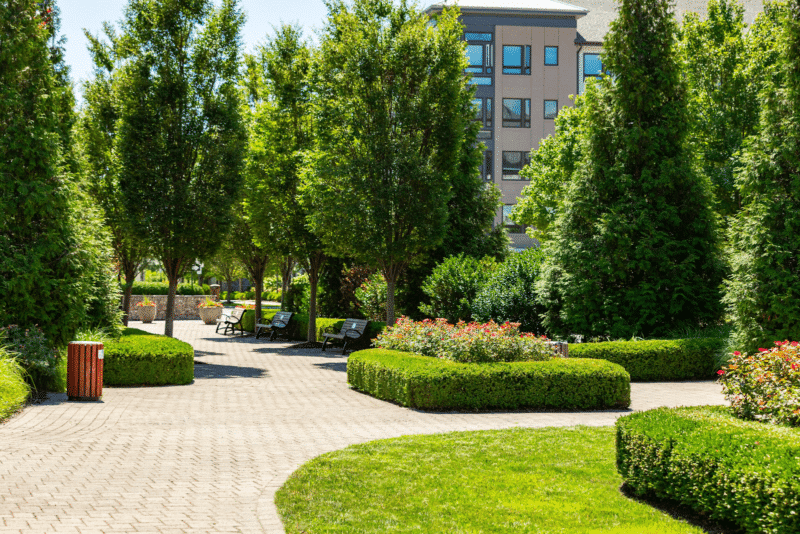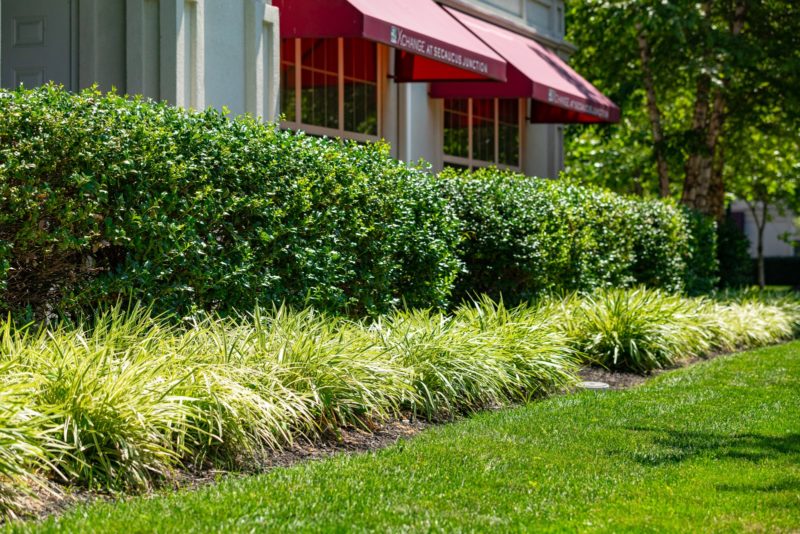 The leaves have dropped, temperatures have dipped and your landscape seems ready to sleep, undisturbed, through another snowy winter.
The leaves have dropped, temperatures have dipped and your landscape seems ready to sleep, undisturbed, through another snowy winter.
No commercial landscaping maintenance worries for a few months, right?
Not exactly.
When to Prune Roses, Hydrangeas, and Trees?
Winter is the best time for dormant pruning of your trees and shrubs. It’s called dormant pruning in the northeast, done from late November through mid-March.
This time of year, your landscape plants have entered their dormancy period. It’s a great time to prune, shape and thin your deciduous plants in preparation for the spring and summer growing season.
Skip pruning, and you put your pretty trees and shrubs in jeopardy.
Let’s take a look at why you shouldn’t skip this important winter pruning task.
Why Prune?
 Pruning can help control the size of a tree, direct growth, encourage flowering or fruiting. It keeps many shrubs and trees happy and healthy. And pruning out broken, diseased and dead branches now will keep them from falling off later, which can be dangerous for pedestrians and property.
Pruning can help control the size of a tree, direct growth, encourage flowering or fruiting. It keeps many shrubs and trees happy and healthy. And pruning out broken, diseased and dead branches now will keep them from falling off later, which can be dangerous for pedestrians and property.
Dormant pruning is important for lots of reasons — and here are seven of them:
Dormant Prune During Winter
Without all the leaves in the way, you can see what you’re doing. The structure of your tree or shrub’s branches is obvious, and easy to follow as you cut.
Fresh pruning cuts typically heal faster during dormant season and are less likely to attract disease-carrying insects.
Most deciduous trees and shrubs can be pruned in winter, as soon as they go dormant.
But don’t touch those evergreens: For the most part, they should be pruned during the actively growing season, since they never become fully dormant.
Pruning For Structure
For young trees, proper pruning helps the tree develop a strong structure and attractive form. A tree that gets appropriate structural pruning while it’s young will need less corrective pruning as it matures.
Skip it, and you could end up with a gangly, overgrown tree that needs tricky fixes later.
Pruning for Safety
Pruning removes diseased, dead, weak or broken branches from your trees.
Skip it, and those branches could fall, injuring people and damaging property.
Vista Pruning
If you have a great view from your porch, deck or window, growing tree branches can quickly obscure it. Proper dormant pruning can carefully remove just the right branches, to open up your view without harming the tree, while keeping a natural look.
Skip it, and your pretty pond will be obscured by branches.
Pruning To Encourage New Growth
When you properly prune a tree or shrub, you promote healthy new growth. It’s also used to cut back fast-growing shoots, suckers or water sprouts to control their growth.
Skip it, and you hamper your tree’s vigorous growth and encourage it to grow in all the wrong places.
Pruning to Increase Longevity
Shrubs and trees that are routinely pruned tend to live longer than those that aren’t trimmed or pruned. Pruning can increase their ability to withstand snow, ice and strong winter storms. Removing crossing branches makes a tree or shrub healthier.
Skip it, and you could lose your tree before its time.
Pruning For Air Circulation
Good air circulation helps keep diseases from setting in. That means thinning the branches that make up the dense mass of your tree or shrub.
Skip it, and your tree is susceptible to insect damage and diseases.
Common Pruning Mistakes
Pruning is an art. It can be tricky. Mistakes can damage your trees and shrubs. Here’s what NOT to do:
Snipping The Tips Of Your Plants
Novice pruners are often squeamish, figuring if they snip a little, they’ll help without harming.
Actually, a few large cuts are better for your tree than a bunch of small ones.
Pruning stimulates the plant to grow, so when you snip the tip of one branch, four to six new branches take its place. Snip those tips off, and the cycle continues, until you have a plant with way too many branches.
“Topping”
Don’t just shear the top off a shrub. This is called “topping,” and will just make the plant send out a crazy configuration of new shoots that will make it even more unmanageable. Follow the natural lines of your tree or shrub as you prune.
Taking Too Much Off
Never remove more than one-quarter of a plant in a season. Overdoing it will encourage sucker growth.
Take lots of breaks to step back and look at what you’ve done. By pruning too much, you can hollow out the center.
Leaving A Stub
Always prune back to a bud or branch. Never leave a stub.
Open ends encourage ugly horizontal sucker-type growth, as well as disease. Prune just above the buds, then new branches will grow from those buds. If possible, the buds should face outward, so the branches will grow toward the outsides of the trees or shrubs.
Skipping Pruning Altogether
Not pruning is probably the most common pruning mistake. We understand. It’s kind of intimidating to make severe cuts on your beloved trees and shrubs.
But your new plants will be happier and healthier come early spring.
Let Neave Handle The Dormant Season Pruning
Still a bit perplexed by dormant pruning? The experts at Neave Group Landscape Management offer winter pruning and years of skilled experience. They know what to prune when and have the skills and tools for the job.
Contact Neave Décor online or by phone at (845) 463-0592 for Hudson Valley, (914) 271-7996 for Westchester, or (203) 212-4800 for Connecticut.
Image: Pruner sharpening
